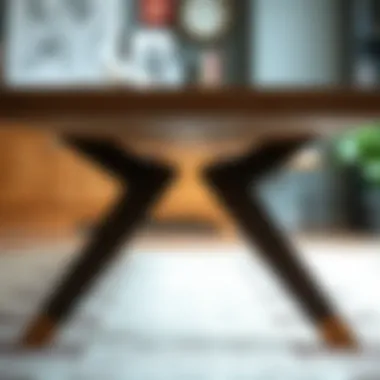Exploring Removable Table Leg Brackets: A Comprehensive Guide


Intro
In today’s world of design, flexibility meets functionality in a bold way. Removable table leg brackets offer a unique solution for those looking to marry style with practicality in their living spaces. From quaint dining tables that morph into expansive workspaces to coffee tables that adapt to varying heights for gatherings, these brackets optimize furniture usability and aesthetics simultaneously.
But why should we even consider such hardware? This guide aims to illuminate the ins and outs of removable table leg brackets, diving into their design, advantages, applications, and installation techniques. Through this exploration, we hope to arm designers, retailers, homeowners, decorators, and architects with the knowledge necessary to implement these components effectively within their projects.
As we navigate through this comprehensive narrative, we’ll also touch on the current trends shaping furniture design, delve into the materials that stand out in the market, and provide maintenance tips that ensure longevity and durability. By the end of this guide, we aim to simplify the decisions involved in incorporating removable table leg brackets into your furniture designs, while also spurring creativity in how you reevaluate your current spaces.
Understanding Removable Table Leg Brackets
In the landscape of modern furniture design, the significance of removable table leg brackets is often understated. Yet, these unassuming components are crucial in allowing furniture to adapt to the varying demands of space and style. Whether one is a designer aiming to create multifunctional pieces or a homeowner looking to maximize their living area, understanding these brackets can open up new possibilities.
What Are Removable Table Leg Brackets?
At their core, removable table leg brackets are hardware fittings that allow the legs of a table to be detached easily. They are designed to facilitate the assembly and disassembly of tables without compromising stability. The beauty of these brackets lies in their simplicity; they can transform a cumbersome piece of furniture into a sleek and manageable unit. Imagine having a dining table that can go from a full-sized setup to a compact storage piece in a matter of minutes. That's the power of removable brackets.
Unlike traditional fixed leg supports, removable options typically incorporate mechanisms that can be released quickly for ease of use. Regular models might employ a simple pin or latch system, while advanced designs often leverage quick-release levers or adjustable arms. Each variety comes with its unique set of benefits, which will be explored later in this guide.
History and Evolution of Table Leg Brackets
Table leg brackets have undergone significant evolution since their inception. Initially, they were rudimentary in design, focusing mainly on functional purposes without much thought toward aesthetics. Early versions were often made of heavy metal, connecting the legs to the tabletop in an almost industrial manner, a far cry from their elegant modern counterparts.
As furniture designers began to prioritize both functionality and style, the design of these brackets evolved. The introduction of lighter materials like aluminum and high-strength plastic facilitated innovative designs that catered not just to support but also to aesthetics. With the rise in demand for space-efficient furniture, particularly in urban settings, removable brackets became a preferred option. Now, they're celebrated for providing flexibility—dynamic pieces that embody the fusion of beauty and practical design.
Today, consumers can find a plethora of designs, from minimalist styles to more elaborate and decorative brackets suitable for various interior designs. The interplay between form and function has made these components not just tools, but essential elements that enhance the overall furniture experience.
In summary, exploring the world of removable table leg brackets reveals the intricate balance between design and utility. For designers, retailers, and homeowners alike, this understanding can lead to more versatile and engaging furniture solutions.
The Design Mechanics of Removable Brackets
When we talk about the design mechanics of removable table leg brackets, we dive into not just how they are made but why they function the way they do. Understanding the design behind these brackets means recognizing their significance in enhancing furniture functionality and adaptability. Whether you’re a designer, a retailer, or a homeowner, knowing the mechanics can help in making informed choices.
The construction of these brackets involves specific elements that contribute prominently to their benefits. Focus on materials, types, and their installation mechanisms can enhance their usability and longevity.
Materials Used in Construction
-#### Metal Brackets
Metal brackets are often the go-to choice for many due to their strength and durability. The key characteristic of metal is its robustness; it can withstand considerable stress when supporting table legs. In the context of removable table leg brackets, the unique feature lies in their ability to provide a secure yet removable connection. This helps maintain structural integrity while ensuring ease of use. However, they can be heavy and sometimes lead to scratches on surfaces if not designed with protective coatings.
-#### Plastic Alternatives
Plastic alternatives bring a different flavor to the party, providing lightweight solutions that are easier to handle. A key feature of these alternatives is their resistance to corrosion and rust, making them particularly useful in environments with high moisture levels. Often less costly, plastic brackets reduce the weight of assembled furniture. However, they may not offer the same load-bearing capacity as metal variants, so consideration about usage scenarios is crucial.
-#### Wooden Components
Wooden components provide a classic aesthetic that appeals to many decorators. The natural look of wood can complement various furniture styles whereas the key benefit is its eco-friendliness. Often sourced sustainably, wooden brackets can bring warmth to a room. However, they are prone to warping or damage in fluctuating humidity levels, necessitating careful maintenance and treatment.
Types of Removable Brackets
-#### Fixed Releasing Mechanisms
Fixed releasing mechanisms are commonly known for their reliability in maintaining a steady hold. The characteristic here is that they remain permanently affixed to either the table or the leg, allowing for a reliable connection when disassembled. While they are less versatile than other options, the assurance of stability makes them a trusted choice for many. The downside may be the added effort required for full disassembly.
-#### Quick-Release Mechanisms
Focus here is on convenience. Quick-release mechanisms allow users to easily detach table legs with minimal effort, making them beneficial for those needing flexibility in space management. The unique feature of these brackets lays in their design for rapid operation, catering to users who often rearrange their furniture. However, the potential trade-off with these ease-of-use mechanisms could be reduced stability, when compared to fixed options.
-#### Adjustable Brackets
Adjustable brackets are incredibly versatile, allowing for fine-tuning the height of the table. The key aspect here is flexibility. When you need a table to adapt to varying needs or user requirements, this can be a beneficial addition. On the flip side, they may require more intricate installation processes, and setup can be a bit fiddly, especially for novices.
In sum, understanding the design mechanics of removable brackets is essential for anyone looking at optimizing furniture functionality. Each type, whether metal, plastic, or wood, carries its unique advantages and disadvantages, shaping decisions on which to use based on specific contexts and needs.
Advantages of Using Removable Table Leg Brackets
Removable table leg brackets provide a host of advantages, making them an essential feature in contemporary furniture design. These brackets not only enhance the functionality of various furniture pieces but also cater to the growing demand for adaptable living spaces. By integrating such elements into furniture design, homeowners, designers, and retailers can be more intentional about maximizing space and improving usability. Here, we will delve into specific benefits, encompassing space-saving capabilities, ease of assembly and disassembly, as well as the versatility in design that these brackets offer.


Space-Saving Capabilities
In an era where urban living often means tighter living conditions, the ability to save space is paramount. Removable table leg brackets shine in this particular area. By allowing tables to be taken apart and stored away when not in use, these brackets help in utilizing every nook and cranny effectively. You can easily fold a table down or change its position depending on the occasion. Imagine a gathering where it’s crucial to create space for movement. Just detach the legs, and voilà, it’s like it miraculously shrank in size, making room for more activities.
Furthermore, the compactness afforded by removable brackets means users can maintain a clutter-free environment. This makes such designs appealing not just for homeowners but also for architects and interior designers looking to optimize spaces without compromising style.
Ease of Assembly and Disassembly
One of the most attractive features of removable table leg brackets is their straightforward assembly and disassembly process. Unlike traditional furniture that can often feel like a jigsaw puzzle, these brackets simplify everything. A quick twist or click is usually all that’s needed to get a table up and running, or to take it down for storage or transport.
Consider families who move frequently or those who enjoy hosting events at home. The quality of life improves immensely when the hassle of set up is minimized. For example, a table can be set up for a holiday dinner and just as easily be disassembled afterward. Such functionality encourages people to make their spaces more versatile without added stress.
Versatility in Design
Another cornerstone advantage of using removable brackets is their adaptability in design. They can work with various materials—from sleek metal to warm wood finishes. This adaptability not only allows for a broader range of aesthetic styles but also facilitates custom solutions that fit the homeowner's exact needs. For instance, a wooden table in a rustic dining area can use removable brackets in a matching finish, creating a seamless look.
Both designers and retailers find great value in this versatility. It opens the door to creative innovations where designers can mix and match styles, colors, and functionality. Plus, furniture retailers add more products to their catalog without the need to radically shift away from their core offerings.
"The clever use of removable brackets is like giving your furniture a second life, allowing for transformations that reflect both function and style."
Applications of Removable Table Leg Brackets
When it comes to furniture design, the use of removable table leg brackets has become increasingly significant. These brackets are not just a functional element; they enhance the flexibility and usability of furniture in varied spaces. Different applications showcase how such brackets allow homeowners and designers to create dynamic environments.
Perfect for Small Spaces
In today’s world, living in compact homes is a common scenario. Removable table leg brackets can be a lifesaver for those whose living areas are tight. Consider a studio apartment or a cozy nook; integrating tables that can be disassembled or tucked away when not in use helps maximize the available space.
When hosting guests, you can easily put up a table, and when the festivities wind down, simply take it apart, allowing for a clutter-free and open area.
"Using removable table legs creates adaptable spaces that are both functional and stylish."
Another enlightening example is folding tables. With removable brackets, these tables can transition from functional dining surfaces to minimalist side tables, catering to different needs without taking permanent space. This flexibility is especially valuable for urban dwellers who value efficiency without sacrificing aesthetics.
Enhancing DIY Projects
For those with a crafty spirit, removable table leg brackets open a door to creativity that seldom goes unnoticed. In DIY projects, these brackets allow users to experiment with diverse designs without committing to a single layout. Imagine building a unique dining table using reclaimed wood; with removable brackets, you can create your dream piece with the option to change it in the future.
Also, as trends in home décor evolve, so can your furniture. You can easily swap out table legs for different styles or finishes, appealing to changing tastes without the need for complete overhauls. This adaptability can elevate the aesthetic of a room and can be exciting for hobbyists and professionals alike. Additionally, for educators and workshop hosts, these brackets facilitate an agile learning environment, where furniture can be adjusted to suit different activities or group sizes.
Commercial Applications and Furniture Retail
In the world of commercial applications, removable table leg brackets hold substantial importance. For restaurants and cafés that frequently rearrange their seating arrangements, these brackets make it easy to transform the dining area to suit various occasions or clientele. By offering flexibility, they allow businesses to make the most of their space, especially during peak hours.
Furniture retailers also benefit from showcasing this type of functionality. Displaying furniture with removable components signals to potential customers that versatility is a priority. Shoppers are often on the lookout for pieces that offer practicality; thus, items featuring removable brackets tend to attract interest.
Moreover, manufacturers continually innovate, leading to increased choices for businesses looking to maximize both style and utility. The ease of installation translates to lower costs in labor and helps maintain a streamlined inventory, further enhancing the importance of these brackets in commercial environments.
Installation Techniques and Best Practices
Understanding the installation techniques and best practices for removable table leg brackets is crucial for ensuring that they perform as intended. Implementing the right methods not only enhances the functionality of your furniture but also contributes to its longevity and stability. In this section, we will focus on key aspects including preparation, the installation process itself, and common mistakes to steer clear of.
Preparation and Tools Required
Before diving headfirst into the installation of removable table leg brackets, it's important to gather the necessary tools and familiarize yourself with the elements involved. Having everything at your fingertips saves time and reduces frustration.
Here are a few essential tools and materials commonly needed:


- Power Drill: A reliable power drill with a set of drill bits will be your best friend during installation.
- Screwdriver: Depending on the bracket design, a flathead or Phillips screwdriver might be necessary.
- Measuring Tape: Precision is key; this helps ensure that your brackets are installed at the right height and distance.
- Level: Using a level during installation will confirm that everything is straight, which is essential for stability.
- Pencil or Marking Tool: For marking spots on your furniture where brackets will be attached.
Preparation also entails assessing the surface of the table and ensuring it is in good condition. A clean work area and an organized mindset set the stage for a hassle-free installation.
Step-by-Step Installation Process
Once you have all the necessary tools, it's time to install the brackets. Here’s a methodical approach to follow:
- Measure and Mark: Begin by measuring where the brackets will go on the table leg and tabletop. Use your pencil or marking tool to indicate these spots clearly.
- Drill Holes: Using your power drill, carefully drill holes in the marked spots. Ensure the drill bit matches the size of the screws or anchors you are using.
- Attach the Brackets: Align the brackets and secure them to the table leg and the tabletop using screws. A tip here: don’t tighten the screws all the way until you make sure everything lines up appropriately.
- Level Check: With the brackets loosely attached, use a level to confirm that everything is aligned correctly. Adjust as necessary.
- Tighten Screws: Once satisfied with the positioning, go ahead and securely tighten all screws.
- Final Inspection: After installation, inspect the brackets to ensure they are sturdy. Make necessary adjustments if you notice anything off.
Following these detailed steps will guarantee a solid installation and functional use.
Common Mistakes to Avoid
Even with clear instructions, there can be hurdles in the installation process. Here are some common pitfalls to watch for:
- Ignoring Manufacturer Instructions: Each bracket may come with its unique set of instructions. It’s easy to overlook these, but they provide vital guidance specific to your chosen model.
- Skipping the Level Check: Not verifying that everything is level before tightening can lead to uneven tables, which is not ideal for usability.
- Overtightening Screws: While it may seem logical to tighten screws as much as possible, overdoing it can damage the material or the bracket itself.
- Not Checking for Stability: After installation, it's wise to test the table’s stability before putting weight on it. Ensure it holds firm as expected.
This guide aims to streamline the installation process, ensuring that your removable table leg brackets provide the functionality and aesthetics you’re aiming for. By preparing adequately, following a systematic approach during installation, and being mindful of common mistakes, you set yourself up for success.
Maintenance of Removable Table Leg Brackets
Maintaining removable table leg brackets is not just a chore; it's a necessity for ensuring both the longevity of the furniture and the safety of its users. While the initial installation may be straightforward, overlooking maintenance can lead to a range of issues, from stability problems to cumbersome assembly processes later on.
Regular maintenance keeps the brackets functioning optimally. This process can enhance the aesthetic appeal of the furniture and prevent potential accidents caused by wear and tear. Brackets, after all, serve as the backbone of furniture stability, and neglected components could compromise that stability, leading to unfortunate consequences.
Cleaning and Upkeep
Cleaning removable table leg brackets is a fundamental aspect of maintenance that often gets skipped. Dust and grime can accumulate, especially in high-use areas. Neglecting these components might result in rust for metal brackets or cracks in plastic ones. Here’s how one can ensure the longevity of these crucial parts:
- Use a Soft Cloth: Regularly wipe the brackets down with a soft, damp cloth. This removes dust without scratching the surface.
- Mild Detergent: For tougher stains, use a mild detergent diluted in water. Avoid harsh chemicals that may damage the material.
- Dry Thoroughly: After cleaning, ensure the brackets are dried completely. Moisture can lead to corrosion or deterioration.
Additionally, when cleaning, it would be wise to take notice of any alterations in the brackets’ condition. A keen eye can catch potential issues before they escalate.
Inspecting for Wear and Tear
Inspecting removable table leg brackets for wear and tear is crucial. Regular checks can save a lot of headaches down the line. Over time, you may find:
- Looseness: With constant movement, bolts or screws might loosen. Regularly tighten these to assure the table remains stable.
- Cracks or Breaks: Inspect for any visible cracks. This can indicate a need for replacement. Clear damage signals that the material is compromised.
- Rust Formation: For metal brackets, any rust indicates a serious issue. If rust compromises the integrity of the bracket, it’s time to replace them.
It’s advisable to create a maintenance schedule, perhaps every few months, to check the condition of the brackets. Keeping a lookout for minor wear can prevent major failures, ensuring that the furniture remains safe and functional for frequent use.
"An ounce of prevention is worth a pound of cure." By dedicating effort to regular maintenance, applicable to all furniture components as well, you will significantly reduce the risk of unexpected issues.
In summary, regular maintenance and inspection of removable table leg brackets are vital for both safety and durability. Consider incorporating cleaning routines along with thorough inspections into your regular home care practices to ensure your furniture remains both functional and stylish.
Potential Drawbacks and Considerations
When discussing removable table leg brackets, it’s essential to address the possible drawbacks and considerations that accompany their use. This part of the guide highlights relevant elements like stability concerns and weight limitations that designers, retailers, homeowners, decorators, and architects might face when incorporating these brackets into their furniture designs. Understanding these factors can help prevent frustrations down the line and ensure that the furniture not only looks great but also functions well.
Stability Concerns
Stability is a primary consideration when using removable table leg brackets. The premise of these brackets is to facilitate ease of assembly and disassembly. However, this can inadvertently affect how stable the furniture is once it’s put together. To get a grip on this, it’s crucial to recognize that the stability often hinges on the bracket design and the quality of materials used.
A poorly designed bracket may not provide the solid base needed to support the tabletop, especially under stress or heavy use. It's vital for designers and users alike to check the locking mechanisms. Some quick-release mechanisms might compromise stability if they loosen over time due to frequent removals. Those who lean on or place weight on the table while it’s in use may find themselves in a precarious situation if the latch isn't secure.


To mitigate such risks, it is recommended to:
- Choose high-quality materials for brackets, such as steel or aluminum, known for their strength.
- Test the assembly by applying stress before using it regularly.
- Incorporate support features, such as cross-bracing or additional legs, to enhance stability.
"Sturdy brackets can prevent the issues that arise when tables wobble or shift under weight. Opting for quality and doing a solid stability check pays off in the long run!"
Weight Limitations
Weight limitations are another significant factor to take into account. Each table leg bracket has its own specifications concerning maximum weight capacity, dictated largely by materials and design. If the furniture is intended for heavier items, like a large tabletop or equipment that could add stress, it's vital to pay attention to these limitations.
Using removable brackets that can’t handle the load may lead to failure points, meaning furniture could become unstable or even collapse under the strain. Therefore, before making a purchase or design decision, one should evaluate:
- The intended use of the table: Is it for dining, working, or showcasing lighter decorative items?
- Stacking or modular considerations: Will additional weight be added over time?
- Brackets suited for heavier applications, such as commercial use or multifunctional pieces.
Remember, when choosing brackets for your table:
- Always check the manufacturer specifications for weight limits.
- If designing, consider appropriate materials that can bear significant weight.
By weighing these drawbacks and considerations, it becomes easier to make informed decisions that ensure the functionality and longevity of tables that utilize removable leg brackets.
Future Innovations in Removable Bracket Design
The concept of removable table leg brackets is at a fascinating juncture. As furniture design continues to evolve, the demand for adaptability and efficiency is more pronounced than ever. Understanding the future innovations in this realm not only highlights the improvements in functionality but also emphasizes how these advancements can enhance the user experience. With a surge in eco-conscious consumers and evolving design trends, it is clear that innovations in removable bracket design are set to shape the landscape of furniture creation and functionality.
Trends in Materials and Technologies
Today's furniture designers are increasingly adopting cutting-edge materials and technologies in removable leg brackets. Gone are the days when metal was the only game in town. Now, we see a mix of materials that push the boundaries of performance and aesthetics.
- Aluminum Alloys: Lightweight yet robust, these materials are becoming popular. They provide superior strength-to-weight ratios, perfect for homeowners eager for style without adding bulk.
- Composites: These materials combine versatility and durability. They can mimic wood or metal appearances while being lighter and often more resistant to environmental wear.
- Smart Technology Integration: Innovations like pressure sensors and locking mechanisms controlled by mobile apps are emerging. This technology allows users to automate the adjustment of the legs, creating even more functional and configurable spaces.
Each of these trends underscores the need to marry form with function, optimizing the user experience while maintaining an eye for design. For designers and architects, these alternatives offer new avenues for creativity while simultaneously addressing environmental and usability concerns.
Sustainability and Eco-friendly Options
As the saying goes, "What goes around comes around," and today's focus on sustainability is a testament to that. In the context of removable table leg brackets, eco-friendly options are not just a trend but a necessity for conscientious designers and homeowners alike.
- Recycled Materials: Brackets made from recycled metals or plastics reduce waste and the ecological footprint. This approach resonates with the environmentally aware consumer, who prefers sustainable options.
- Bamboo and Other Fast-Growing Materials: Utilizing bamboo for non-metal brackets provides a natural aesthetic and is a renewable resource. Its rapid growth cycle ensures a lesser ecological impact compared to traditional lumber.
- Non-Toxic Finishes: Eco-friendly finishes free of harmful chemicals not only protect the products but also ensure they are safe for family environments, appealing to health-conscious consumers.
The importance of integrating sustainability into design cannot be overstated. It represents a shift in mindset, moving towards a world where function does not compromise the health of the planet. As furniture evolves, those in the industry must consider how their choices impact both their consumers and the environment.
Investing in sustainable materials today lays the groundwork for a more responsible and conscious design future.
Epilogue
Removable table leg brackets play a pivotal role in modern furniture design, merging functionality with aesthetic appeal. In an age where adaptability and multipurpose furniture are increasingly valued, understanding these components is key for anyone engaged in furniture design or home improvement. These brackets not only simplify assembly and disassembly but also provide a refreshing approach to maximizing usable space in tight environments.
The Role of Removable Table Leg Brackets in Modern Furniture Design
In the realm of contemporary furniture, flexibility is king. Designers and consumers alike are searching for furniture that serves multiple functions without sacrificing style. Removable table leg brackets are squarely in this trend, allowing users to easily configure, reconfigure, and store furniture as needs shift. These brackets facilitate custom designs without interfering with the visual appeal of the product.
The versatility they bring is unmistakable. Imagine a dining table that can morph into a workstation with just a flick. It's these little innovations that elevate ordinary pieces to bespoke creations, catering to specific needs and spaces. Designers are finding new ways to incorporate these brackets into more creative and sustainable solutions, enhancing not just the function of furniture, but also its ability to adapt to changing lifestyles.
Encouraging Creative Design Solutions
Embracing removable table leg brackets fosters a culture of creativity and experimentation in design. By breaking down traditional notions of fixed furniture, designers can explore a plethora of configurations and styles. From picnic tables that convert into benches to coffee tables that can double as desks, possibilities are vast.
"The only limit to our realization of tomorrow will be our doubts of today."
" - Franklin D. Roosevelt
Such innovative uses resonate particularly well with younger markets that favor eclectic and personalized styles over the banal uniformity often found in conventional furniture.
When it comes to incorporating these brackets into design, the emphasis should be on not just aesthetics, but also function. Customizing leg placements or experimenting with diverse materials can lead to signature pieces that tell unique stories. As furniture designers venture into the realm of modular designs, the ability to combine form and function will be more valuable than ever.
In summary, the importance of removable table leg brackets in modern design cannot be overstated. They represent a shift towards more intelligent living spaces, intertwining practicality with artistic expression. As this trend continues to grow, both designers and consumers will benefit from their various applications and innovative design potential.







